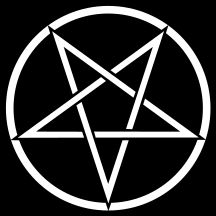
Theistic Satanism, otherwise referred to as traditional Satanism, religious Satanism, or spiritual Satanism,[2] is an umbrella term for religious groups that consider Satan, the Devil, to objectively exist as a deity, supernatural entity, or spiritual being worthy of worship or reverence, whom individuals may believe in, contact, and convene with, in contrast to the atheistic archetype, metaphor, or symbol found in LaVeyan Satanism.[2][3][4]
Organizations who uphold theistic Satanist beliefs most often have few adherents, are loosely affiliated or constitute themselves as independent groups and cabals, which have largely self-marginalized.[5] Another prominent characteristic of theistic Satanism is the use of various types of magic.[2] Most theistic Satanist groups exist in relatively new models and ideologies, many of which are independent of the Abrahamic religions.[2][4][6]
In addition to the worship of Satan or the Devil in the Abrahamic sense, religious traditions based on the worship of other "adversarial" gods—usually borrowed from pre-Christian polytheistic religions—are often included within theistic Satanism, and most theistic Satanist groups exist in relatively new models and ideologies.[2] Theistic Satanist organizations may incorporate beliefs and practices borrowed from Gnosticism, Hermeticism, Neo-Paganism, New Age, the left-hand path, black magic, ceremonial magic, Crowleyan magick, Western esotericism, occult traditions, and sorcery.[2][4][7]
- ^ Petersen 2004, pp. 444–446.
- ^ a b c d e f Abrams, Joe (Spring 2006). Wyman, Kelly (ed.). "The Religious Movements Homepage Project – Satanism: An Introduction". virginia.edu. University of Virginia. Archived from the original on 29 August 2006. Retrieved 30 December 2020.
- ^ Partridge 2004, p. 82.
- ^ a b c Lewis, James R. (August 2001b). "Who Serves Satan? A Demographic and Ideological Profile". Marburg Journal of Religion. 6 (2). University of Marburg: 1–25. doi:10.17192/mjr.2001.6.3748. ISSN 1612-2941. Retrieved 30 December 2020.
- ^ Holt & Petersen 2016, pp. 447–448.
- ^ Petersen 2004, pp. 424–427, 442–443.
- ^ Petersen 2004, pp. 424–427.